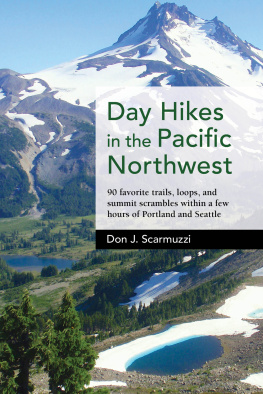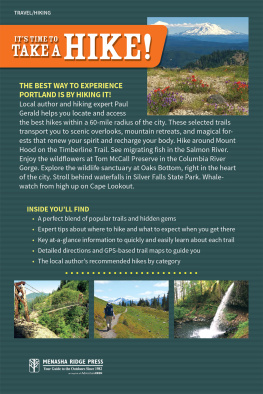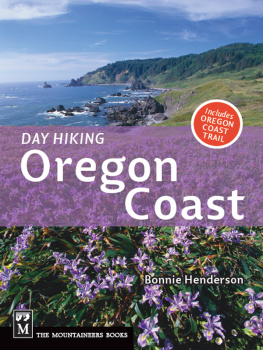Portland Forest Hikes

PORTLAND FOREST HIKES
TWENTY CLOSE-IN WILDERNESS WALKS
James D. Thayer

Frontispiece: A trail through Portlands last remaining grove of old-growth firs beckons the hiker.
Facts stated in this book are to the best of the authors knowledge true, although bus routes and other specifics are subject to change without notice. The author and publisher can take no responsibility for the misidentification of mushrooms or plants by the users of this book nor for any illness that might result from their consumption. If there is any doubt whatsoever about the identity and edibility of a mushroom or plant, do not eat it. Users should exercise caution when hiking in wilderness areas; the maps in this book are as accurate as possible but limited in detail.
Maps by Erik Goetze, The Art of Geography
All photographs by James D. Thayer
Copyright 2008 by James D. Thayer. All rights reserved.
Published in 2008 by
Timber Press, Inc.
The Haseltine Building
133 S.W. Second Avenue, Suite 450
Portland, Oregon 97204-3527, U.S.A.
www.timberpress.com
Designed by Susan Applegate
Printed in China
Library of Congress Cataloging-in-Publication Data
Thayer, James D.
Portland Forest Hikes: Twenty close-in wilderness walks/James D. Thayer.
p. cm.
Includes bibliographical references and index.
ISBN-13: 978-0-88192-857-0
1. TrailsOregonTualatin MountainsGuidebooks. 2. Tualatin
Mountains (Or.)Guidebooks. I. Title.
GV199.42.O7T53 2008
796.5209795dc22 2007027205
To my parents
Charles W. Thayer and Cynthia Dunn Thayer,
who instilled in me a lifelong love of nature
and a passion for exploring the deep woods


Contents
Acknowledgments
This book owes much of its inspiration to the pioneering work of Keith Hay. Keiths original vision of the Pacific Greenway remains firmly rooted in many of our minds and refuses to go away.
I am equally indebted to Ding Canon, Bill Keil, Thornton Munger, and C. Paul Keyser, all key contributors to the founding of Forest Park. I was honored to work with both Ding and Bill when I first joined what was then still called the Committee of Fifty. Their long-term determination gives me hope that great ideas can be realized in Oregon as long as youre patient and stubborn as hell.
And then theres Marcy Houle, whose wonderful One Citys Wilderness provided the scientific backbone to the concept of a wildlife corridor. Without the inspiration to find out where that corridor went and how it functioned, I would still be happily puttering around the Hoyt Arboretum.
There are so many others who have helped me along the way and who I would like to thank. My wife, Cynthia, is foremost among them for her patience in putting up with my routine disappearing acts, which usually ended with heaps of muddy clothes and a filthy, exhausted Siberian husky whose first act upon returning home was to jump on the couch. A special thanks to my faithful companions Loki, Buddy, and Pal for accompanying me on my many expeditions, and to DoveLewis Emergency Animal Hospital for saving Lokis life after he was kicked by an elk.
My thanks go out to all those who helped me turn a jumble of ideas into a book, including the very talented editor Mindy Fitch. Without Eve Goodmans patience and encouragement at Timber Press, this book never would have been possible. Erik Goetzes lucid maps made the trails come alive in ways no amount of words could have achieved. I would like to thank Metro for helping me with many detail aerial maps, and David Bragdon in particular for helping me understand the regional scope of this project. Thanks, too, to Laura Foster for her review and contributions, and to Ian Hall for his evaluation of my information about mushrooms.
Finally there are the many nameless people upon whom I chanced while walking up these dusty roads, who told me about homesteading on Dixie Mountain, bootlegging in Linnton, and plenty of other fascinating stories. Oh, theres definitely gold out there in them hills if you can only listen! Thanks to all of you who added your intricate piece to the puzzle.

The Jones Creek Hike: a 2-mile exploration into the northern edge of Multnomah County
Introduction
The idea for this book originated in the 1990s. In 1992 Keith Hay, founder of the American Greenways Program, proposed a bold initiative called the Pacific Greenway project. It sought to establish three separate routes that would connect Forest Park with the Coast Range, thus protecting a major wildlife corridor while also providing a trail system through some of northwest Oregons thickest forests in a part of the state that has received little recognition.
Imagine hiking trails from Portland to the Coast Range: it may some day be possible. This dream inspired this book of twenty wilderness hikes, each starting where the vision begins, closest to Portland. Certainly the more remote additions to our hiking repertoire are on the horizon as a growing population of hikers, runners, bikers, and equestrians continue to seek new venues for explorations in the northwest quadrant of Oregon.
Most modern cities are now surrounded by a wide belt of privately held, semi-developed lands that offer little opportunity for recreational access or enjoyment. Portland is unique in this respect. The northwest quadrant of the city is dominated by Forest Park, which is the basis for ten of the twenty trails in this volume. At 5000 acres it ranks as the largest natural urban forest reserve in the United States, stretching across 8 miles of wooded hillsides in the Tualatin Mountains. This sylvan peninsula extending into Portland offers tremendous hiking experiences, especially in the remoter areas described in this book. Concealed beyond it lie larger and more majestic woods that extend in a continuous forested carpet along the lower Columbia River all the way to the Pacific. Some of the most beautiful of these forests, with their labyrinthine networks of logging roads, are a mere thirty-minute drive from downtown Portland.
Basic guidance to the more accessible and popular trails of Forest Park, such as the Wildwood Trail and Leif Erikson Drive, is easy to come by. But there are dozens of other lesser-known urban trails that are literally off the beaten track and eminently worth seeking out for their quiet, undisturbed ambiance and for the rugged beauty of their natural settings. In addition to introducing these lesser-known trails inside Forest Park, this guide invites you into some rarely described prime Oregon hiking country that is nearly as close to Portland. The northern portion of the Tualatin Mountains, essentially a spur of the Coast Range that divides the Tualatin Valley from the Columbia River, is a treasure trove of close-in, accessible hikes of remarkable beauty and surprising remoteness, and is full of local cultural history. After more than four years of intensive exploration, research, Global Positioning System (GPS) mapping, and interviews with local residents, I am pleased to include nine hikes in the northern Tualatin Mountains.
Next page









